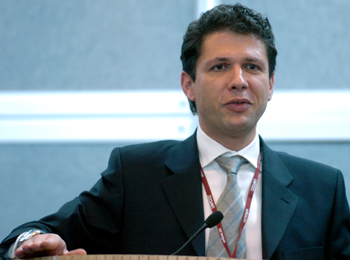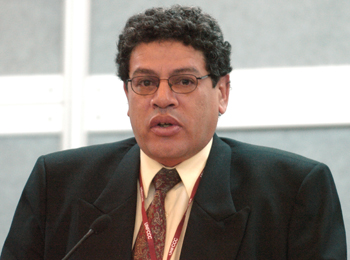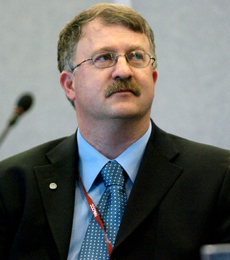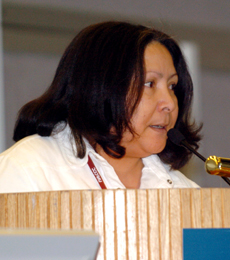 |
||
|
published by IISD, the International Institute for Sustainable Development
in cooperation with the UNFCCC Secretariat. |
|||
|
Special Report on Selected Side Events at COP 11 & Kyoto Protocol COP/MOP 1
|
|||||
| 28 November - 9 December 2005 | Montréal, Canada | |||||
|
Adaptation to climate change: lessons learned, work in progress, and next steps in Latin America Presented by the World Bank |
|||
|
Walter Vargara, World Bank, presented a report on the Bank’s initiatives on adaptation activities in Latin America and the Caribbean. He highlighted some of the impacts of climate change such as coral bleaching, glacier retreat, intensification of intense hurricanes and health impacts and noted the Bank’s newly constituted fund for addressing priority adaptation issues. He emphasized some of the programme areas: building awareness and strengthening the knowledge base; creating an enabling environment for adaptation and adaptation activities, such as a Coastal Ecosystem Restoration in Trinidad and the Central Andes Regional Adaptation project.
Hiroki Kondo, Frontier Research Center for Global Change, Japan, presented a series of climate change projections conducted using the Earth Simulator and its research outcomes relating to adaptation projects in Columbia and the Caribbean. Kenrick Leslie, Caribbean Community Climate Change Center, illustrated a World Bank/ GEF project on the Special Programme on Adaptation in the Caribbean which is based on an integrated approach to address climate change, coastal biodiversity and land degradation. Carlos Costas, Colombian Institute of Meteorological Hydrology and Environmental Studies, presented the Integrated National Adaptation Plan (INAP), a GEF/World Bank project. He listed some climate change impacts in Columbia, such as precipitation and temperature changes, loss of coral, collapse of marine and land based ecosystem, and impacts on human health. He said INAP aims to target high mountain ecosystems, insular areas and areas with increases in malaria and dengue infection. Julio Garcia, National Environmental Council, Peru, outlined activities relating to mainstreaming adaptation into development in the Andean region. Noting some of the impacts of the climate change, he called for expanding adaptation efforts across national borders. Corinne Valdevia and Frank Sperling, World Bank, presented the Bank’s activities relating to climate risk management in communities in Peru. They highlighted four participatory rural assessments in Peruvian communities which examined the role of local knowledge systems and barriers to adaptation, conducted risk mapping and assessed local coping strategies. Discussion: participants discussed opportunities for inter-regional cross pollination of work on adaptation and the role of traditional coping practices. Participants also reflected on climate change awareness and its effects on community’s livelihoods. |
|||
|
|||
|
||||||||||||||||||||||||||||||||||||||||||||||||||
|
|||
|
||||||||||||||||||||||||||||||||||
|
|||
|
Africa and the CDM: Opportunities and Constraints Presented by Malawi |
|||||
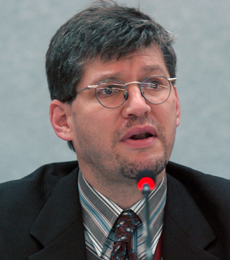 |
Philip Gwage, Department of Meteorology, Uganda, emphasized framing CDM activities in terms of poverty reduction, and facilitating the mobilization of resources and reduction of investor risk.
Richard Muyungi, Division of Environment, Tanzania, underscored that the CDM is a market-driven process, stressed the importance of information flow, and stated that having a designated national authority (DNA) is a basic requirement. Steve Thorne, SouthSouthNorth, shared his experience in developing and registering CDM projects, emphasizing transparency in the development of quality projects with local ownership. Bernhard Schlamadinger, Joanneum Research, addressed non-renewable biomass, stating that currently afforestation and reforestation are the only land-use activities eligible for CDM credits, and that there is little room for Africa to gain credits from reducing fossil fuel consumption. |
||||
| Bernhard Schlamadinger, Joanneum Research, suggested that the CDM should recognize benefits achieved through solar cookers and improved efficiency | |||||
|
William Greene, Africa Practice, discussed their actions to promote responsible foreign direct investment, including a guide for Carbon Finance for Africa, and noted the need to streamline CDM modalities. Emily Massawa, Africa Group, stated that the CDM Executive Board’s decision to exclude non-renewable biomass will make it difficult for Africa to benefit from the CDM. Discussion: participants discussed the potential for regional DNAs, and ways to address the lack of CDM projects in Africa. |
|||||
|
|||
|
Exchange of views on the support to non-Annex I Parties to prepare national communications Presented by UNFCCC |
|||||
 |
Claudine Moussounda, Greenhouse Gas Project Manager, Gabon, reviewed national experience in developing climate change communications including, sectoral adaptation and mitigation strategies, and experience using MAGICC and SCENGEN software.
Aderito Santana, National Focal Point, Sao Tome and Principe, reviewed efforts to identify vulnerable sectors and analyze adaptation possibilities. He outlined common challenges encountered, such as lack of data, national experts, training materials in appropriate languages and coordination. Taka Hiraishi, IPCC, described the coordinating and harmonizing role of workshops and an ongoing analysis of 41 out of 127 national communications completed to date. Dominique Revet, UNFCCC, described improvements in GHG inventory software for non Annex I (NAI) countries and identified software training sources. |
||||
| Martha Perdomo, National Commumnications Support Programme, describes types of support available to non-Annex I countries | |||||
|
Martha Perdomo, National Communications Support Programme, described the support available for preparation of national communications, which includes: priority setting; methods and tools; dissemination; capacity development; integration into national development plans; and a training workshop for second national communications. She identified a number of UNDP, World Bank, and USAID regional support projects. Susan Wickwire, US, and Mathew Holder, UK, described their support for national communications. Discussion: participants focused on funding gaps for particular issues such as cost-benefit analysis and the translation of materials. |
|||||
|
|||
|
Sustainable CDM – best practice Presented by myclimate |
|||||
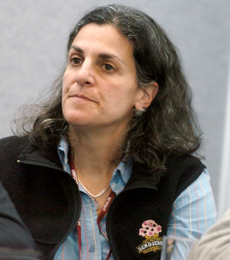 |
Renat Heuberger, myclimate, said the panel will focus on the CDM’s role in assisting non Annex I Parties in achieving sustainable development and Annex I Parties in complying with their reduction commitments.
Andrea Asch, Ben & Jerry’s Homemade, described ways in which the company is aiming at reducing its emissions by 10% by 2007 such as improving plant efficiencies, evaluating new technology, and carbon offsetting. Asch said there was a five year return on investment for new projects. Sven Bode, Hamburg Institute of International Economics, said the midterm potential in terms of market share for CERs/VERs from small sustainable projects is limited. Einar Telnes, Det Norske Veritas, described the ways in which small projects could have high sustainability benefits, including allowing for large scale bundling with small scale methodologies and building understanding among regulators that non-renewable biomass projects should be treated as fuel switch and not as LULUCF. Agus Sari, SouthSouthNorth, stressed that for CDM to be sustainable it has to be well designed, implemented and evaluated. |
||||
| Andrea Asch, Ben&Jerry’s, explained how, with the help from NativeEnergy’s Green Tag Futures, Ben & Jerry reduced their carbon dioxide emissions, while supporting the development of a community wind turbine | |||||
| János Maté, Greeenpeace International, introduced the Solar Chill project that replaces vaccine coolers with a solar cooler that does not require batteries and said half a million tons of carbon dioxide will be saved over the next 15 years. | |||||
|
|||
|
Bioenergy and climate change mitigation Presented by FAO |
|||||
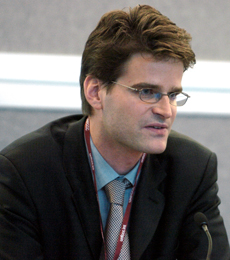 |
Ingmar Juergens, FAO, emphasized the importance of capturing the value of environmental services, and suggested rising oil prices may drive the demand for bio-energy.
Christina Woerlen, GEF, highlighted that although bio-fuel holds potential, projects should be scrutinized to ensure they yield positive results. Jan Kappen, UNEP, discussed environmental due diligence for bio-energy systems and risk assessment. Michael Schlup highlighted the benefits of using “The Gold Standard”, an NGO approach to assessing sustainable development benefits of CDM projects. Discussion: participants discussed the need for the financial sector to evaluate the costs and benefits associated with investing in bio-energy. |
||||
| Jan Kappen, UNEP, stated that project risk assessment needs to address environmental, economic and social aspects in order to put sustainability at the centre of investment decisions | |||||
|
|||
|
FAO global forest resource assessment 2005 Presented by FAO |
|||||
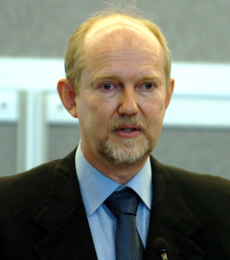 |
Lars Gunnar Marklund and Dieter Schoene, FAO, described the scope, process and importance of the Global Forest Resource Assessment, which considers many variables, several of which are pertinent to climate change. They listed key findings including: continued high rates of deforestation; increases in the extent of plantations; and that forest carbon stocks are decreasing by 1.1 Gt per year. They noted the importance of soil, which often contains more carbon than trees.
They discussed various parameters linked to the accuracy and reliability of results obtained, including the use of expansion factors, root-shoot ratios, and data quality. Discussion focused on the definition of “forest” used in the assessment, and how deforestation figures translate to GHG emissions. |
||||
| Lars Gunnar Marklund, FAO, presented the 2005 Global Forest Resource Assessment, based on country reports, and described how they filled data gaps | |||||
|
|||
|
Sectoral approaches for future international actions Presented by the Center for Clean Air Policy |
||||||||
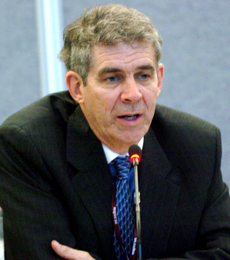 |
Jake Schmidt, Center for Clean Air Policy (CCAP), introduced the sectoral approach being discussed by some major developed and developing country climate negotiators.
Ned Helme, CCAP, described features of this “Sectoral Pledge Approach”, being proposed as a post 2012 option, including sector-specific voluntary commitments to achieve intensity targets in major energy and industry sectors. He stated that if the top ten largest GHG emitting developing countries in each sector were included, 80 to 90% of developing country emissions would be addressed. Adrian Fernandes, Mexico, said this voluntary approach should appeal to developing countries and that determining the sectoral benchmarks necessary to qualify for G-8 financing would be a challenge. Artur Runge-Metzger, EU, said the EU could achieve 20% reductions at no net cost since savings would equal cost of needed changes. He said the “top 10” approach is interesting but raises problems of equity. |
|||||||
| Ned Helme, Center for Clean Air Policy, described the bottom up approach to obtain sectoral pledges | ||||||||
| Harald Dovland, Norwegian Ministry of Environment, preferred a cross-sectoral approach, setting national goals to which sectors contribute.
Jennifer Morgan, WWF, called for additional information on this approach. |
||||||||
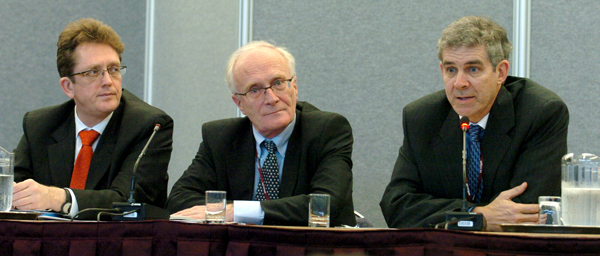 |
||||||||
| L-R: Artur Runge-Metzger, European Commission, Harald Dovland, Ministry of Environment of Norwaym, and Ned Helme, President,Center for Clean Air Policy |
||||||||
|
|||
|
||
|
Click the above button to go back to our ENB main coverage
|
||
|
|
|
|
|
||
|



